Analysis of Information Systems for a Small Family Business (MIS100)
VerifiedAdded on 2022/08/21
|9
|1772
|13
Report
AI Summary
This report analyzes the information systems needs of a small family-run restaurant, addressing challenges such as manual processes, inefficient inventory management, and outdated transaction recording. The report begins by outlining the core components of information technology, including hardware, software, telecommunications, and databases, and discusses their roles within a business context. It then explores various types of computer-based information systems, such as Transaction Processing Systems (TPS), Management Information Systems (MIS), Decision Support Systems (DSS), and Executive Support Systems (ESS). The report recommends specific information systems to improve the restaurant's operations, including an inventory management system to track supplies, a Transaction Processing System (TPS) to automate financial records, and a Marketing Information System to engage customers. The conclusion emphasizes the importance of integrating these systems to enhance efficiency, streamline processes, and support the restaurant's growth. The report references several academic sources to support its analysis and recommendations.
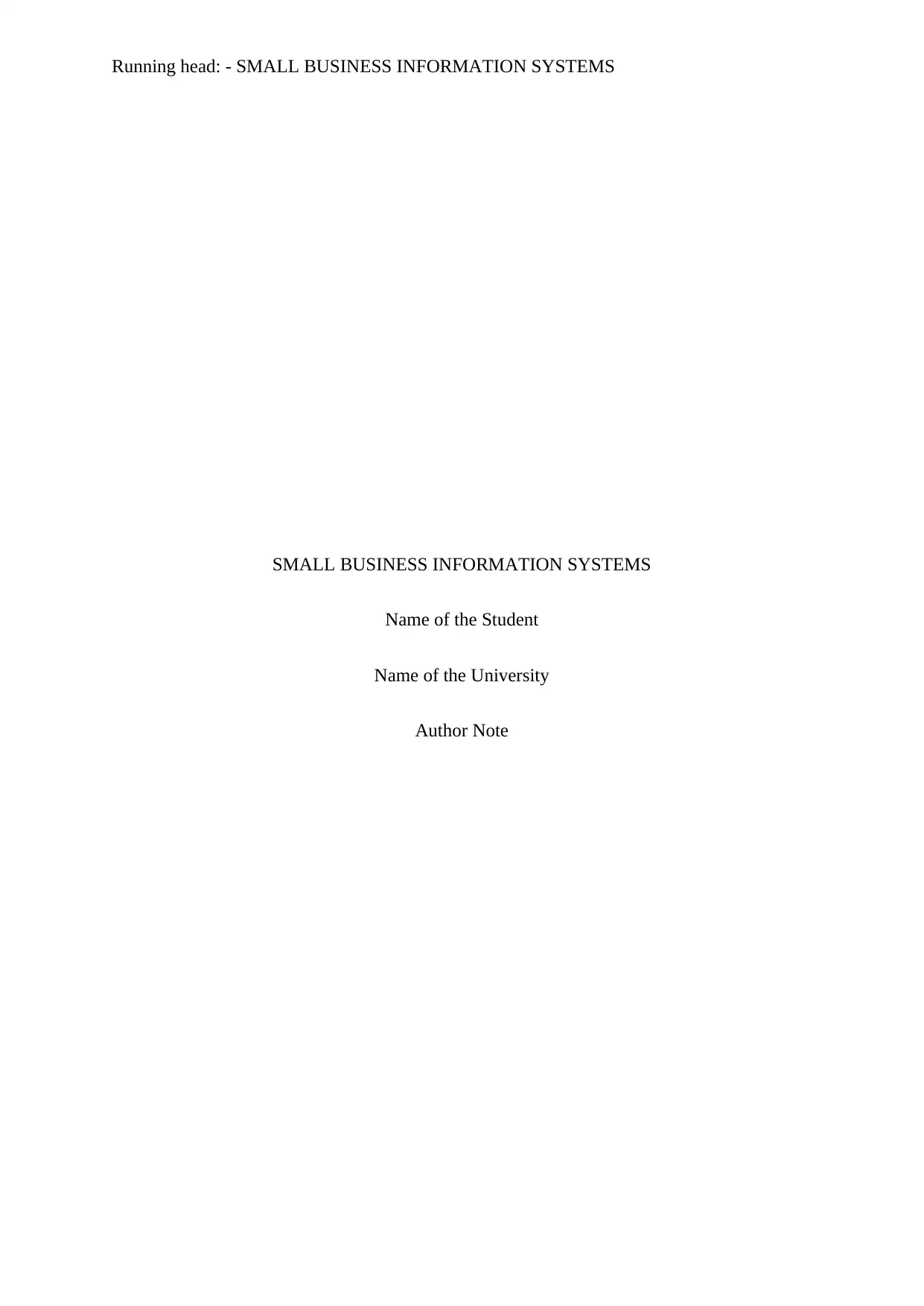
Running head: - SMALL BUSINESS INFORMATION SYSTEMS
SMALL BUSINESS INFORMATION SYSTEMS
Name of the Student
Name of the University
Author Note
SMALL BUSINESS INFORMATION SYSTEMS
Name of the Student
Name of the University
Author Note
Paraphrase This Document
Need a fresh take? Get an instant paraphrase of this document with our AI Paraphraser
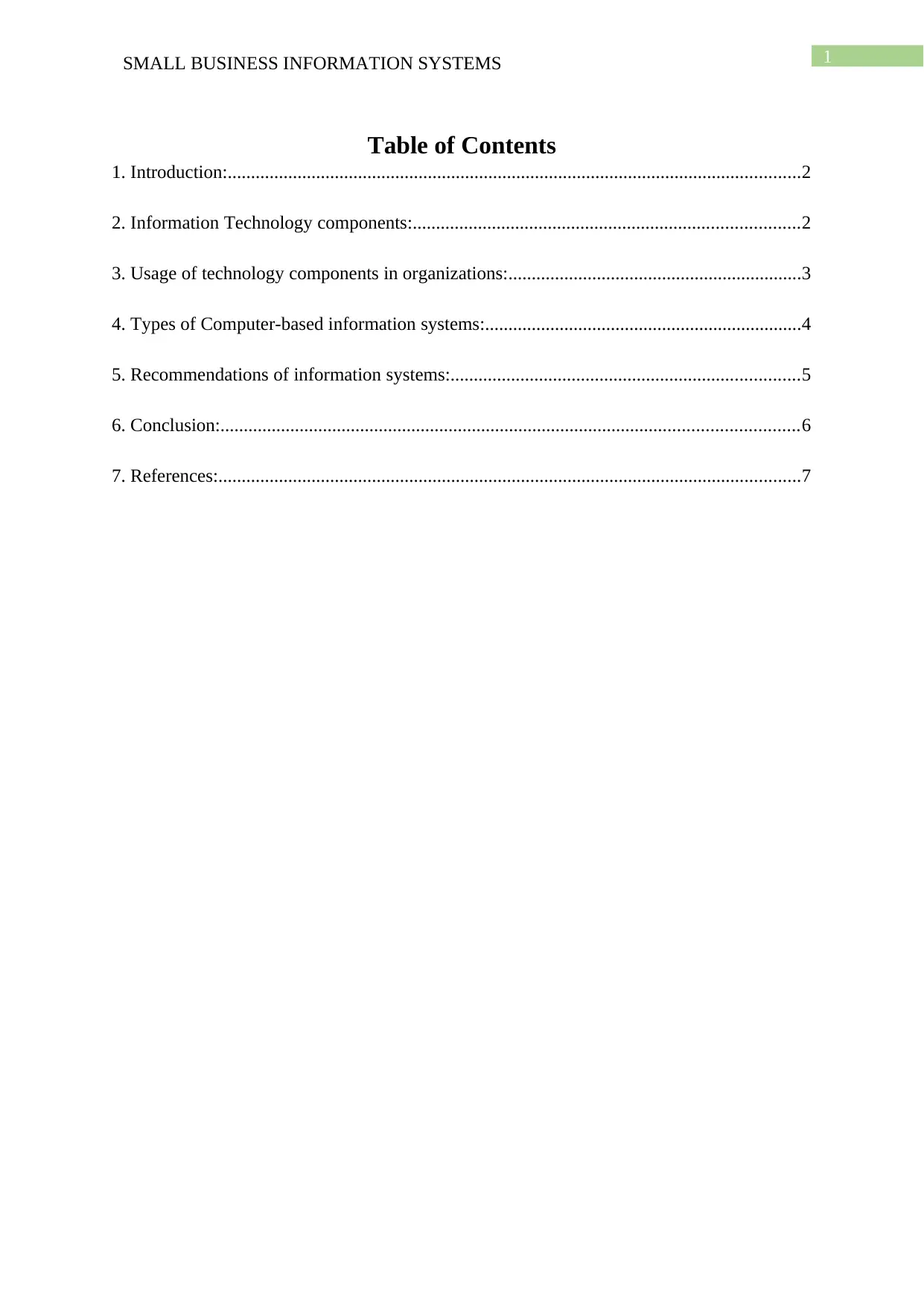
1SMALL BUSINESS INFORMATION SYSTEMS
Table of Contents
1. Introduction:...........................................................................................................................2
2. Information Technology components:...................................................................................2
3. Usage of technology components in organizations:...............................................................3
4. Types of Computer-based information systems:....................................................................4
5. Recommendations of information systems:...........................................................................5
6. Conclusion:............................................................................................................................6
7. References:.............................................................................................................................7
Table of Contents
1. Introduction:...........................................................................................................................2
2. Information Technology components:...................................................................................2
3. Usage of technology components in organizations:...............................................................3
4. Types of Computer-based information systems:....................................................................4
5. Recommendations of information systems:...........................................................................5
6. Conclusion:............................................................................................................................6
7. References:.............................................................................................................................7
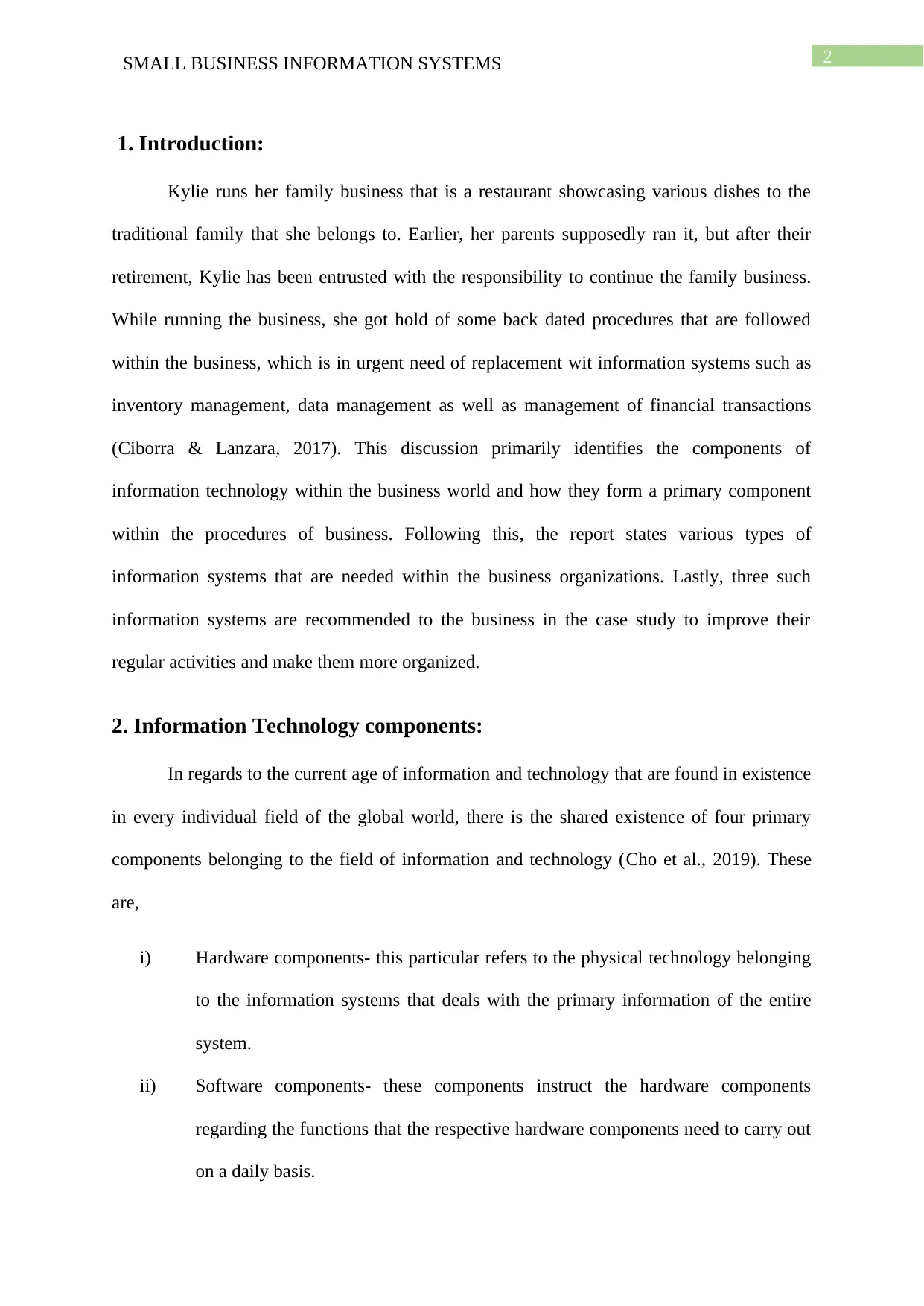
2SMALL BUSINESS INFORMATION SYSTEMS
1. Introduction:
Kylie runs her family business that is a restaurant showcasing various dishes to the
traditional family that she belongs to. Earlier, her parents supposedly ran it, but after their
retirement, Kylie has been entrusted with the responsibility to continue the family business.
While running the business, she got hold of some back dated procedures that are followed
within the business, which is in urgent need of replacement wit information systems such as
inventory management, data management as well as management of financial transactions
(Ciborra & Lanzara, 2017). This discussion primarily identifies the components of
information technology within the business world and how they form a primary component
within the procedures of business. Following this, the report states various types of
information systems that are needed within the business organizations. Lastly, three such
information systems are recommended to the business in the case study to improve their
regular activities and make them more organized.
2. Information Technology components:
In regards to the current age of information and technology that are found in existence
in every individual field of the global world, there is the shared existence of four primary
components belonging to the field of information and technology (Cho et al., 2019). These
are,
i) Hardware components- this particular refers to the physical technology belonging
to the information systems that deals with the primary information of the entire
system.
ii) Software components- these components instruct the hardware components
regarding the functions that the respective hardware components need to carry out
on a daily basis.
1. Introduction:
Kylie runs her family business that is a restaurant showcasing various dishes to the
traditional family that she belongs to. Earlier, her parents supposedly ran it, but after their
retirement, Kylie has been entrusted with the responsibility to continue the family business.
While running the business, she got hold of some back dated procedures that are followed
within the business, which is in urgent need of replacement wit information systems such as
inventory management, data management as well as management of financial transactions
(Ciborra & Lanzara, 2017). This discussion primarily identifies the components of
information technology within the business world and how they form a primary component
within the procedures of business. Following this, the report states various types of
information systems that are needed within the business organizations. Lastly, three such
information systems are recommended to the business in the case study to improve their
regular activities and make them more organized.
2. Information Technology components:
In regards to the current age of information and technology that are found in existence
in every individual field of the global world, there is the shared existence of four primary
components belonging to the field of information and technology (Cho et al., 2019). These
are,
i) Hardware components- this particular refers to the physical technology belonging
to the information systems that deals with the primary information of the entire
system.
ii) Software components- these components instruct the hardware components
regarding the functions that the respective hardware components need to carry out
on a daily basis.
⊘ This is a preview!⊘
Do you want full access?
Subscribe today to unlock all pages.

Trusted by 1+ million students worldwide
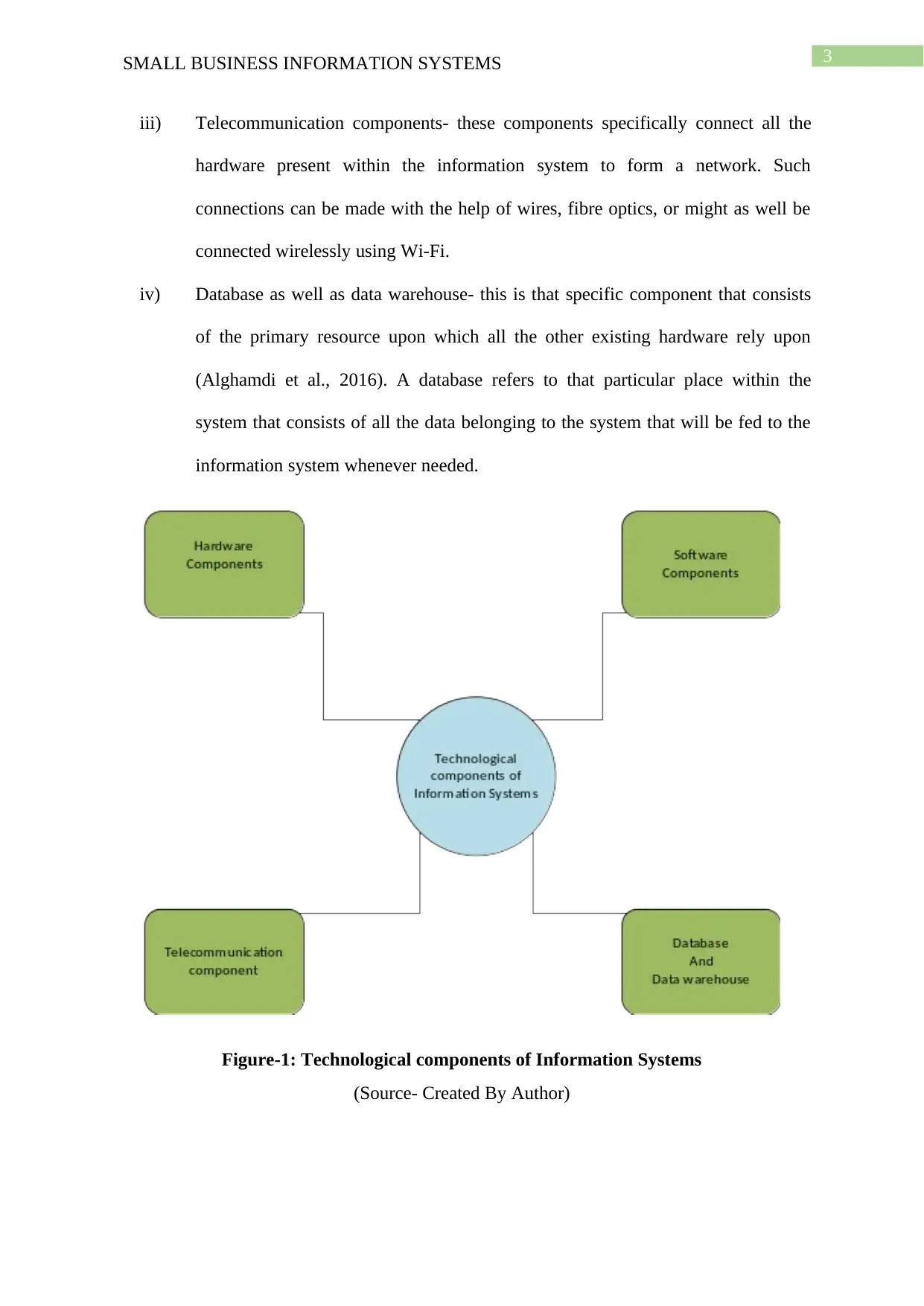
3SMALL BUSINESS INFORMATION SYSTEMS
iii) Telecommunication components- these components specifically connect all the
hardware present within the information system to form a network. Such
connections can be made with the help of wires, fibre optics, or might as well be
connected wirelessly using Wi-Fi.
iv) Database as well as data warehouse- this is that specific component that consists
of the primary resource upon which all the other existing hardware rely upon
(Alghamdi et al., 2016). A database refers to that particular place within the
system that consists of all the data belonging to the system that will be fed to the
information system whenever needed.
Figure-1: Technological components of Information Systems
(Source- Created By Author)
iii) Telecommunication components- these components specifically connect all the
hardware present within the information system to form a network. Such
connections can be made with the help of wires, fibre optics, or might as well be
connected wirelessly using Wi-Fi.
iv) Database as well as data warehouse- this is that specific component that consists
of the primary resource upon which all the other existing hardware rely upon
(Alghamdi et al., 2016). A database refers to that particular place within the
system that consists of all the data belonging to the system that will be fed to the
information system whenever needed.
Figure-1: Technological components of Information Systems
(Source- Created By Author)
Paraphrase This Document
Need a fresh take? Get an instant paraphrase of this document with our AI Paraphraser
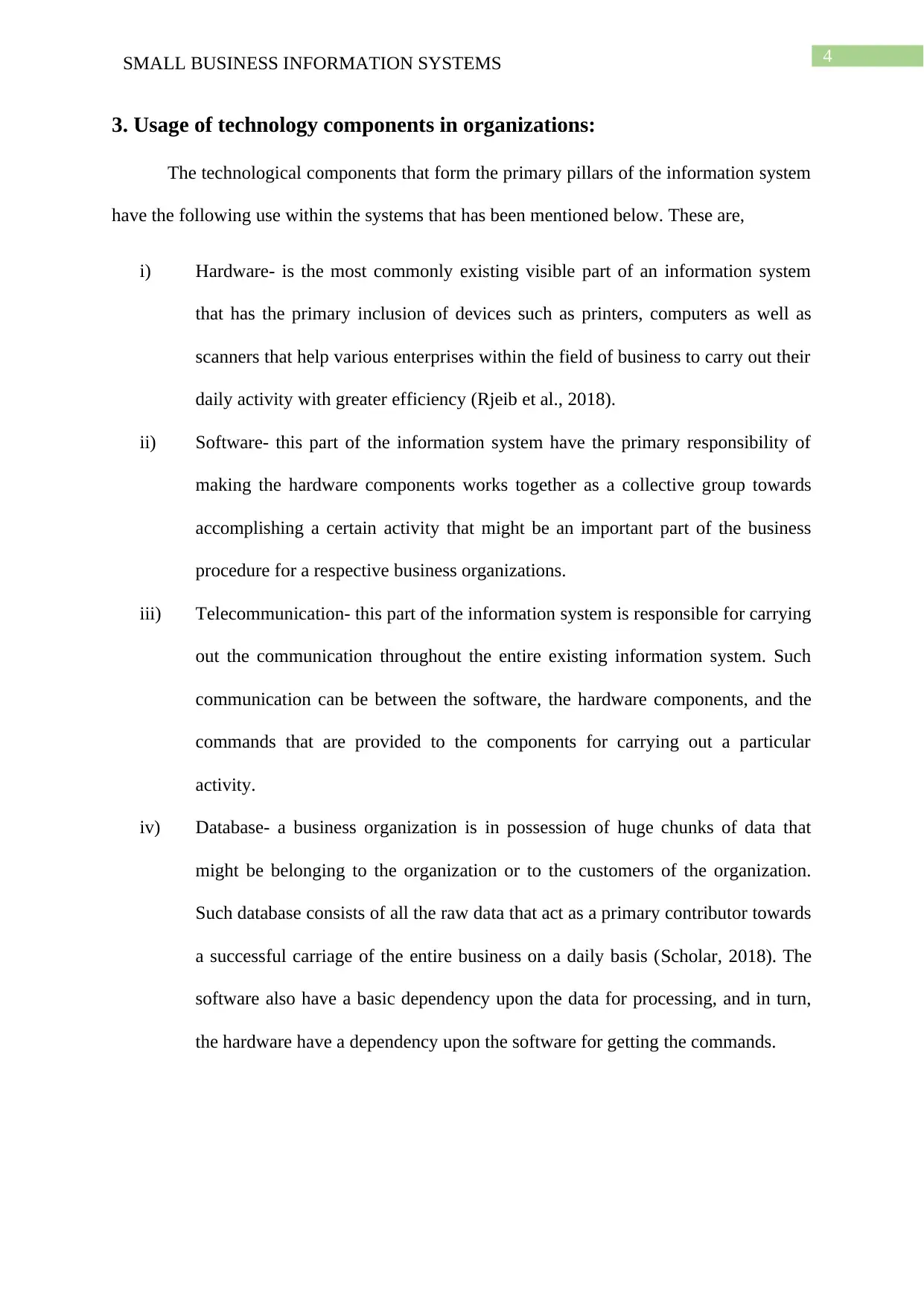
4SMALL BUSINESS INFORMATION SYSTEMS
3. Usage of technology components in organizations:
The technological components that form the primary pillars of the information system
have the following use within the systems that has been mentioned below. These are,
i) Hardware- is the most commonly existing visible part of an information system
that has the primary inclusion of devices such as printers, computers as well as
scanners that help various enterprises within the field of business to carry out their
daily activity with greater efficiency (Rjeib et al., 2018).
ii) Software- this part of the information system have the primary responsibility of
making the hardware components works together as a collective group towards
accomplishing a certain activity that might be an important part of the business
procedure for a respective business organizations.
iii) Telecommunication- this part of the information system is responsible for carrying
out the communication throughout the entire existing information system. Such
communication can be between the software, the hardware components, and the
commands that are provided to the components for carrying out a particular
activity.
iv) Database- a business organization is in possession of huge chunks of data that
might be belonging to the organization or to the customers of the organization.
Such database consists of all the raw data that act as a primary contributor towards
a successful carriage of the entire business on a daily basis (Scholar, 2018). The
software also have a basic dependency upon the data for processing, and in turn,
the hardware have a dependency upon the software for getting the commands.
3. Usage of technology components in organizations:
The technological components that form the primary pillars of the information system
have the following use within the systems that has been mentioned below. These are,
i) Hardware- is the most commonly existing visible part of an information system
that has the primary inclusion of devices such as printers, computers as well as
scanners that help various enterprises within the field of business to carry out their
daily activity with greater efficiency (Rjeib et al., 2018).
ii) Software- this part of the information system have the primary responsibility of
making the hardware components works together as a collective group towards
accomplishing a certain activity that might be an important part of the business
procedure for a respective business organizations.
iii) Telecommunication- this part of the information system is responsible for carrying
out the communication throughout the entire existing information system. Such
communication can be between the software, the hardware components, and the
commands that are provided to the components for carrying out a particular
activity.
iv) Database- a business organization is in possession of huge chunks of data that
might be belonging to the organization or to the customers of the organization.
Such database consists of all the raw data that act as a primary contributor towards
a successful carriage of the entire business on a daily basis (Scholar, 2018). The
software also have a basic dependency upon the data for processing, and in turn,
the hardware have a dependency upon the software for getting the commands.
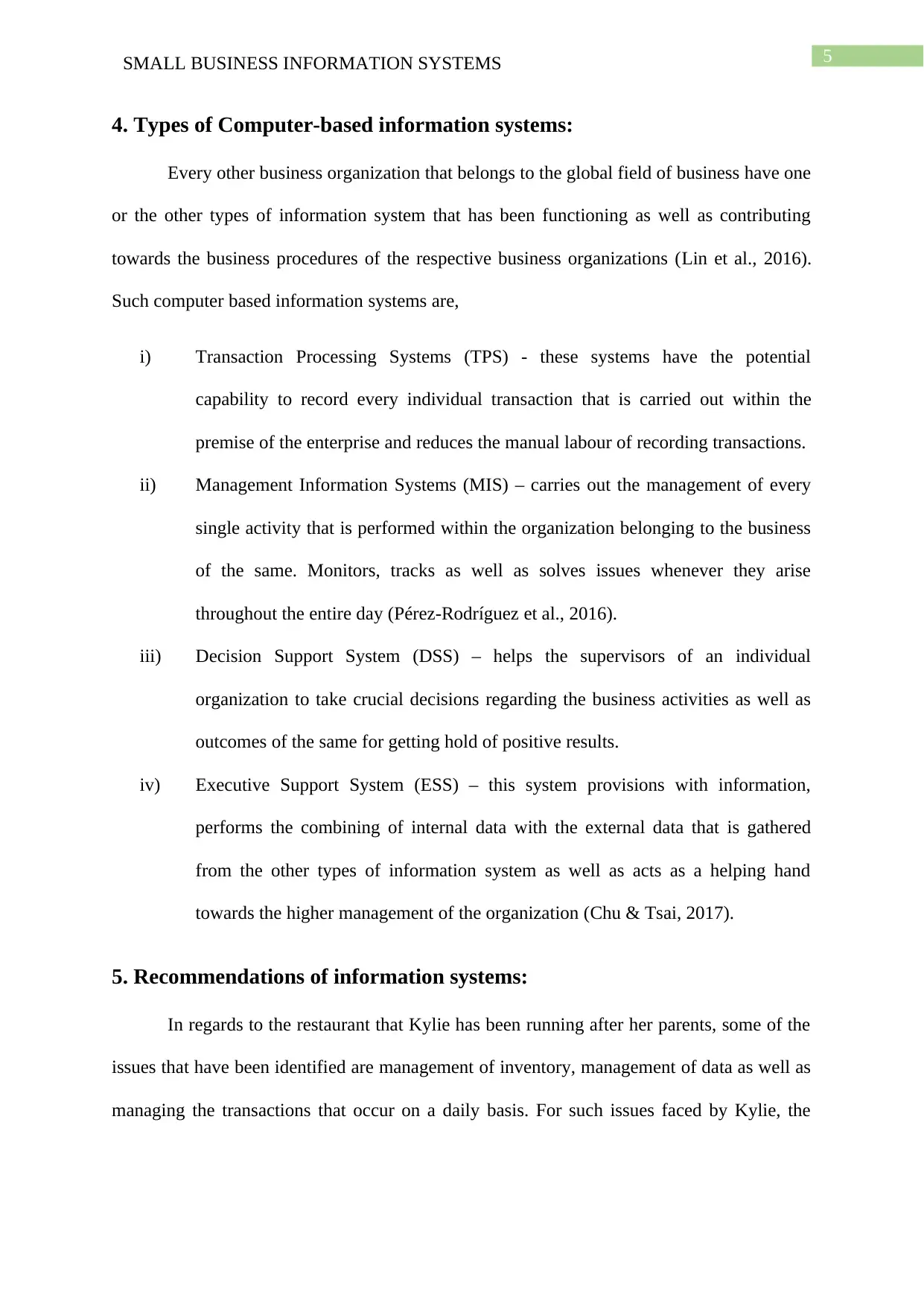
5SMALL BUSINESS INFORMATION SYSTEMS
4. Types of Computer-based information systems:
Every other business organization that belongs to the global field of business have one
or the other types of information system that has been functioning as well as contributing
towards the business procedures of the respective business organizations (Lin et al., 2016).
Such computer based information systems are,
i) Transaction Processing Systems (TPS) - these systems have the potential
capability to record every individual transaction that is carried out within the
premise of the enterprise and reduces the manual labour of recording transactions.
ii) Management Information Systems (MIS) – carries out the management of every
single activity that is performed within the organization belonging to the business
of the same. Monitors, tracks as well as solves issues whenever they arise
throughout the entire day (Pérez-Rodríguez et al., 2016).
iii) Decision Support System (DSS) – helps the supervisors of an individual
organization to take crucial decisions regarding the business activities as well as
outcomes of the same for getting hold of positive results.
iv) Executive Support System (ESS) – this system provisions with information,
performs the combining of internal data with the external data that is gathered
from the other types of information system as well as acts as a helping hand
towards the higher management of the organization (Chu & Tsai, 2017).
5. Recommendations of information systems:
In regards to the restaurant that Kylie has been running after her parents, some of the
issues that have been identified are management of inventory, management of data as well as
managing the transactions that occur on a daily basis. For such issues faced by Kylie, the
4. Types of Computer-based information systems:
Every other business organization that belongs to the global field of business have one
or the other types of information system that has been functioning as well as contributing
towards the business procedures of the respective business organizations (Lin et al., 2016).
Such computer based information systems are,
i) Transaction Processing Systems (TPS) - these systems have the potential
capability to record every individual transaction that is carried out within the
premise of the enterprise and reduces the manual labour of recording transactions.
ii) Management Information Systems (MIS) – carries out the management of every
single activity that is performed within the organization belonging to the business
of the same. Monitors, tracks as well as solves issues whenever they arise
throughout the entire day (Pérez-Rodríguez et al., 2016).
iii) Decision Support System (DSS) – helps the supervisors of an individual
organization to take crucial decisions regarding the business activities as well as
outcomes of the same for getting hold of positive results.
iv) Executive Support System (ESS) – this system provisions with information,
performs the combining of internal data with the external data that is gathered
from the other types of information system as well as acts as a helping hand
towards the higher management of the organization (Chu & Tsai, 2017).
5. Recommendations of information systems:
In regards to the restaurant that Kylie has been running after her parents, some of the
issues that have been identified are management of inventory, management of data as well as
managing the transactions that occur on a daily basis. For such issues faced by Kylie, the
⊘ This is a preview!⊘
Do you want full access?
Subscribe today to unlock all pages.

Trusted by 1+ million students worldwide
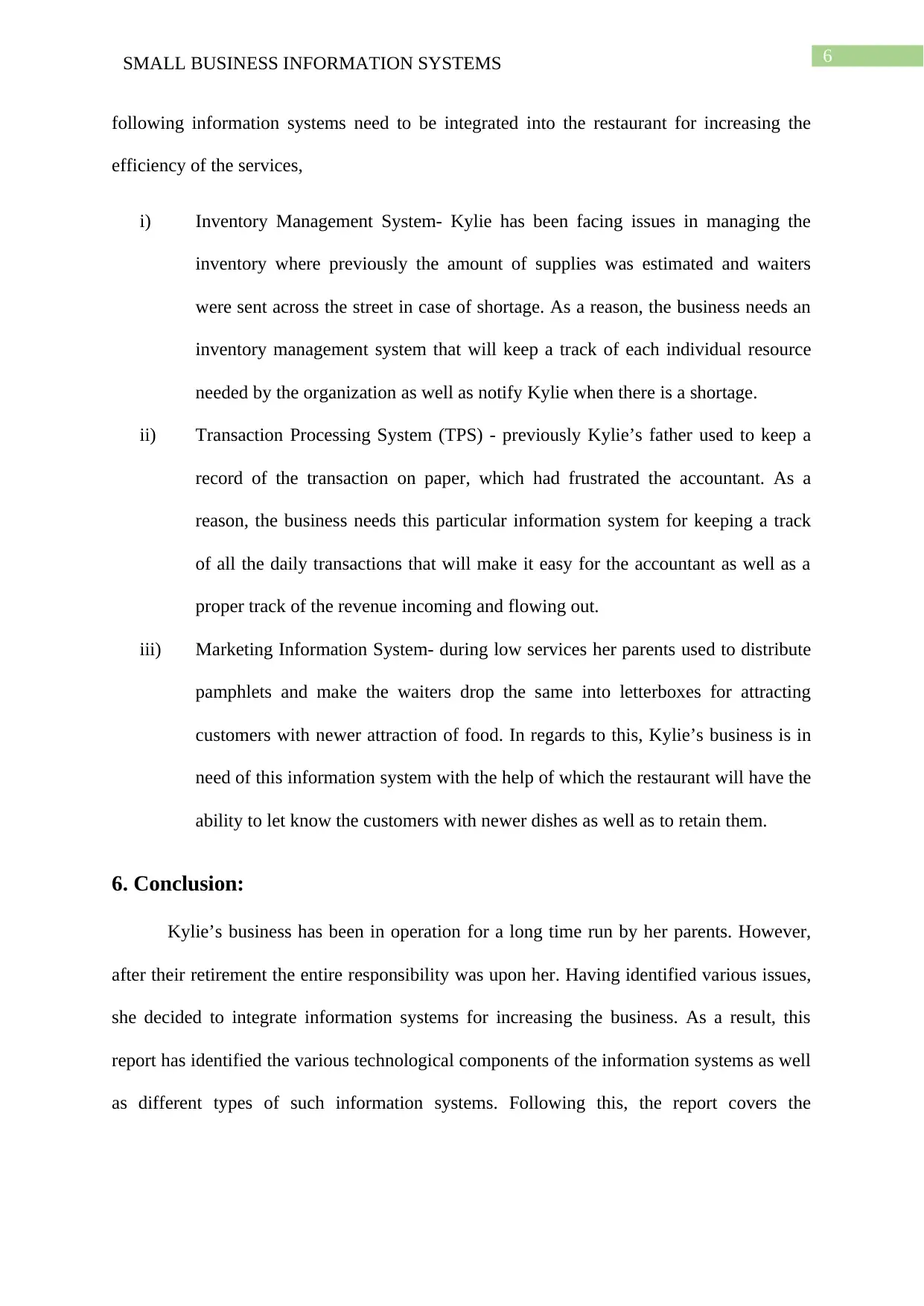
6SMALL BUSINESS INFORMATION SYSTEMS
following information systems need to be integrated into the restaurant for increasing the
efficiency of the services,
i) Inventory Management System- Kylie has been facing issues in managing the
inventory where previously the amount of supplies was estimated and waiters
were sent across the street in case of shortage. As a reason, the business needs an
inventory management system that will keep a track of each individual resource
needed by the organization as well as notify Kylie when there is a shortage.
ii) Transaction Processing System (TPS) - previously Kylie’s father used to keep a
record of the transaction on paper, which had frustrated the accountant. As a
reason, the business needs this particular information system for keeping a track
of all the daily transactions that will make it easy for the accountant as well as a
proper track of the revenue incoming and flowing out.
iii) Marketing Information System- during low services her parents used to distribute
pamphlets and make the waiters drop the same into letterboxes for attracting
customers with newer attraction of food. In regards to this, Kylie’s business is in
need of this information system with the help of which the restaurant will have the
ability to let know the customers with newer dishes as well as to retain them.
6. Conclusion:
Kylie’s business has been in operation for a long time run by her parents. However,
after their retirement the entire responsibility was upon her. Having identified various issues,
she decided to integrate information systems for increasing the business. As a result, this
report has identified the various technological components of the information systems as well
as different types of such information systems. Following this, the report covers the
following information systems need to be integrated into the restaurant for increasing the
efficiency of the services,
i) Inventory Management System- Kylie has been facing issues in managing the
inventory where previously the amount of supplies was estimated and waiters
were sent across the street in case of shortage. As a reason, the business needs an
inventory management system that will keep a track of each individual resource
needed by the organization as well as notify Kylie when there is a shortage.
ii) Transaction Processing System (TPS) - previously Kylie’s father used to keep a
record of the transaction on paper, which had frustrated the accountant. As a
reason, the business needs this particular information system for keeping a track
of all the daily transactions that will make it easy for the accountant as well as a
proper track of the revenue incoming and flowing out.
iii) Marketing Information System- during low services her parents used to distribute
pamphlets and make the waiters drop the same into letterboxes for attracting
customers with newer attraction of food. In regards to this, Kylie’s business is in
need of this information system with the help of which the restaurant will have the
ability to let know the customers with newer dishes as well as to retain them.
6. Conclusion:
Kylie’s business has been in operation for a long time run by her parents. However,
after their retirement the entire responsibility was upon her. Having identified various issues,
she decided to integrate information systems for increasing the business. As a result, this
report has identified the various technological components of the information systems as well
as different types of such information systems. Following this, the report covers the
Paraphrase This Document
Need a fresh take? Get an instant paraphrase of this document with our AI Paraphraser
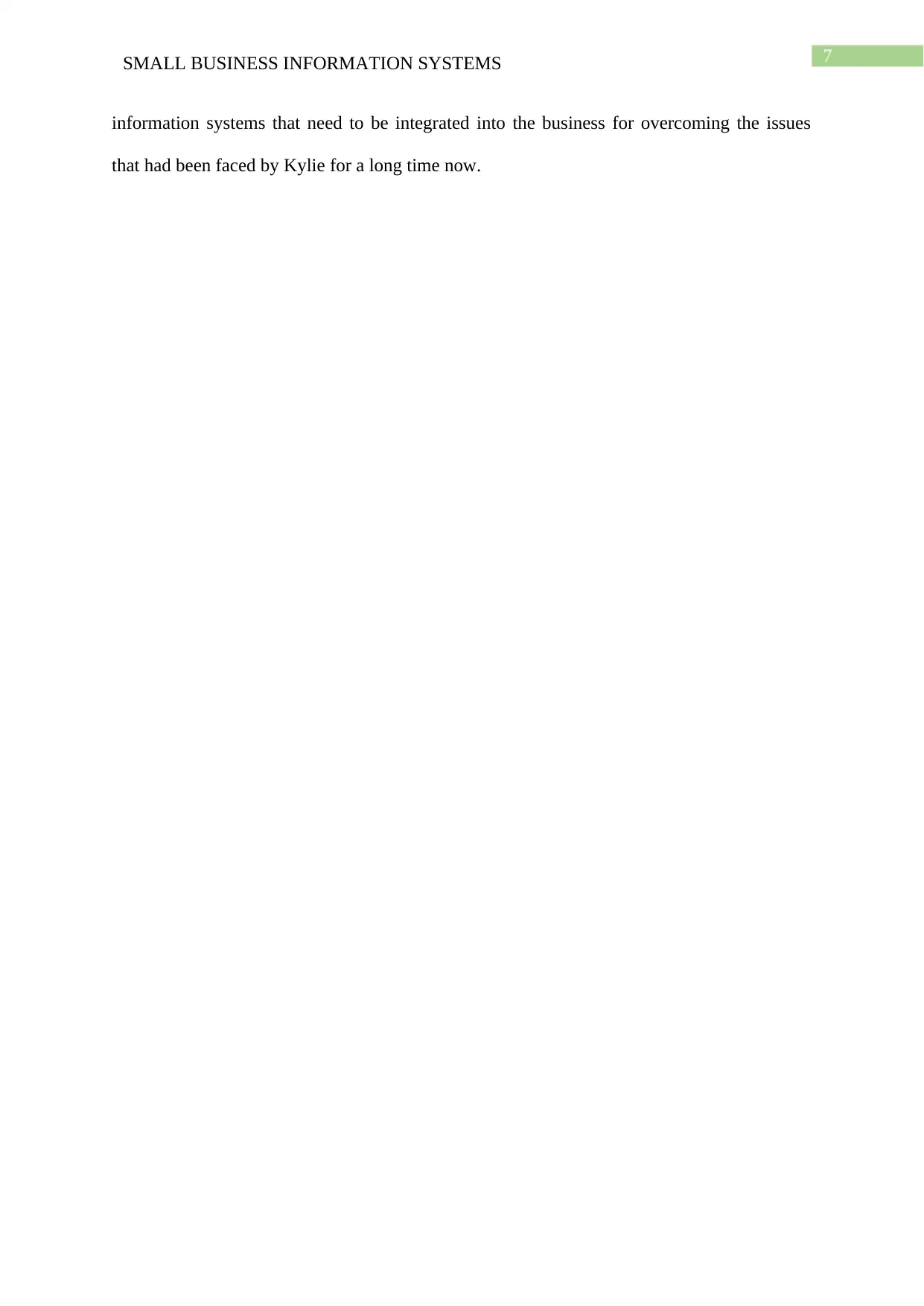
7SMALL BUSINESS INFORMATION SYSTEMS
information systems that need to be integrated into the business for overcoming the issues
that had been faced by Kylie for a long time now.
information systems that need to be integrated into the business for overcoming the issues
that had been faced by Kylie for a long time now.
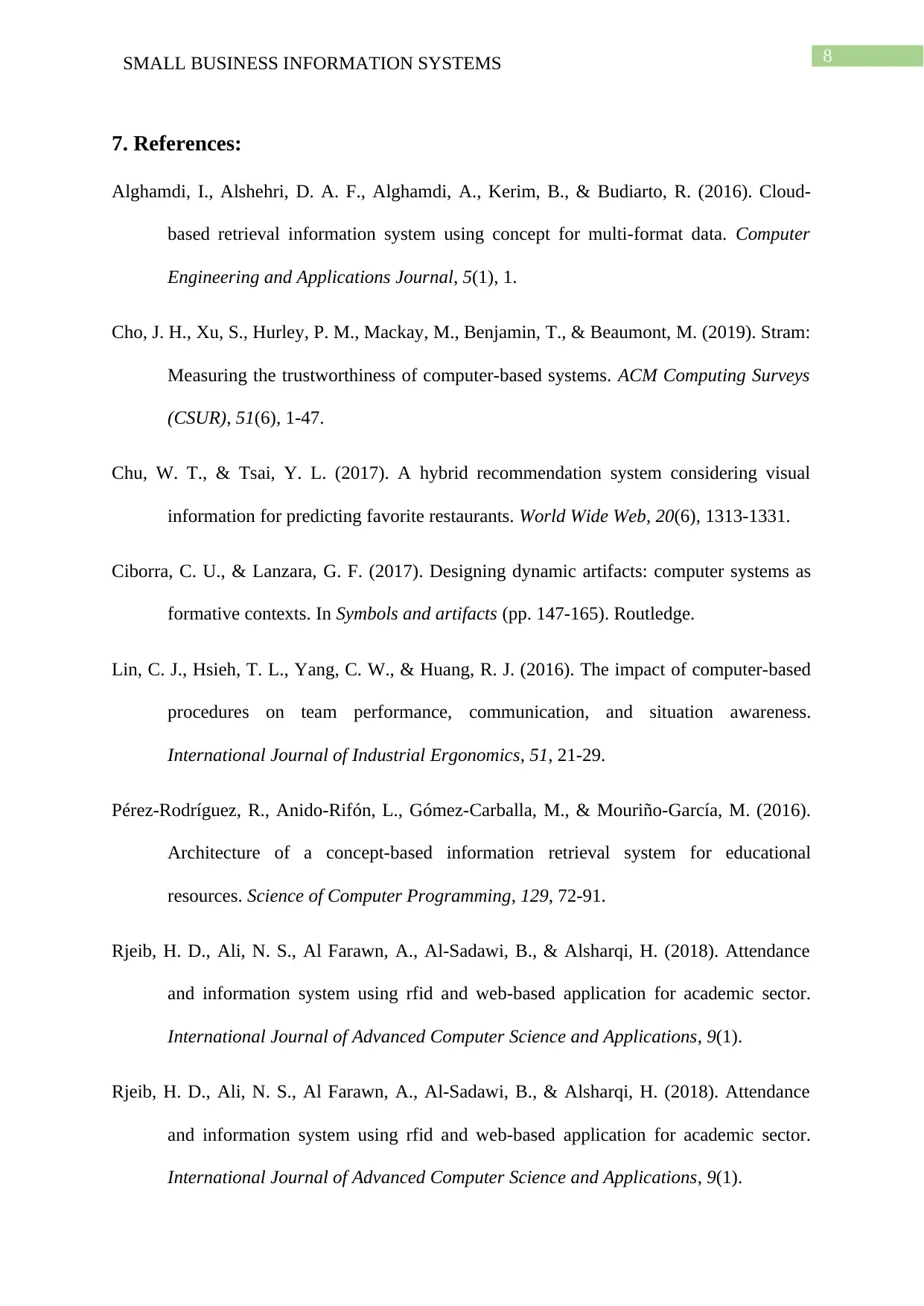
8SMALL BUSINESS INFORMATION SYSTEMS
7. References:
Alghamdi, I., Alshehri, D. A. F., Alghamdi, A., Kerim, B., & Budiarto, R. (2016). Cloud-
based retrieval information system using concept for multi-format data. Computer
Engineering and Applications Journal, 5(1), 1.
Cho, J. H., Xu, S., Hurley, P. M., Mackay, M., Benjamin, T., & Beaumont, M. (2019). Stram:
Measuring the trustworthiness of computer-based systems. ACM Computing Surveys
(CSUR), 51(6), 1-47.
Chu, W. T., & Tsai, Y. L. (2017). A hybrid recommendation system considering visual
information for predicting favorite restaurants. World Wide Web, 20(6), 1313-1331.
Ciborra, C. U., & Lanzara, G. F. (2017). Designing dynamic artifacts: computer systems as
formative contexts. In Symbols and artifacts (pp. 147-165). Routledge.
Lin, C. J., Hsieh, T. L., Yang, C. W., & Huang, R. J. (2016). The impact of computer-based
procedures on team performance, communication, and situation awareness.
International Journal of Industrial Ergonomics, 51, 21-29.
Pérez-Rodríguez, R., Anido-Rifón, L., Gómez-Carballa, M., & Mouriño-García, M. (2016).
Architecture of a concept-based information retrieval system for educational
resources. Science of Computer Programming, 129, 72-91.
Rjeib, H. D., Ali, N. S., Al Farawn, A., Al-Sadawi, B., & Alsharqi, H. (2018). Attendance
and information system using rfid and web-based application for academic sector.
International Journal of Advanced Computer Science and Applications, 9(1).
Rjeib, H. D., Ali, N. S., Al Farawn, A., Al-Sadawi, B., & Alsharqi, H. (2018). Attendance
and information system using rfid and web-based application for academic sector.
International Journal of Advanced Computer Science and Applications, 9(1).
7. References:
Alghamdi, I., Alshehri, D. A. F., Alghamdi, A., Kerim, B., & Budiarto, R. (2016). Cloud-
based retrieval information system using concept for multi-format data. Computer
Engineering and Applications Journal, 5(1), 1.
Cho, J. H., Xu, S., Hurley, P. M., Mackay, M., Benjamin, T., & Beaumont, M. (2019). Stram:
Measuring the trustworthiness of computer-based systems. ACM Computing Surveys
(CSUR), 51(6), 1-47.
Chu, W. T., & Tsai, Y. L. (2017). A hybrid recommendation system considering visual
information for predicting favorite restaurants. World Wide Web, 20(6), 1313-1331.
Ciborra, C. U., & Lanzara, G. F. (2017). Designing dynamic artifacts: computer systems as
formative contexts. In Symbols and artifacts (pp. 147-165). Routledge.
Lin, C. J., Hsieh, T. L., Yang, C. W., & Huang, R. J. (2016). The impact of computer-based
procedures on team performance, communication, and situation awareness.
International Journal of Industrial Ergonomics, 51, 21-29.
Pérez-Rodríguez, R., Anido-Rifón, L., Gómez-Carballa, M., & Mouriño-García, M. (2016).
Architecture of a concept-based information retrieval system for educational
resources. Science of Computer Programming, 129, 72-91.
Rjeib, H. D., Ali, N. S., Al Farawn, A., Al-Sadawi, B., & Alsharqi, H. (2018). Attendance
and information system using rfid and web-based application for academic sector.
International Journal of Advanced Computer Science and Applications, 9(1).
Rjeib, H. D., Ali, N. S., Al Farawn, A., Al-Sadawi, B., & Alsharqi, H. (2018). Attendance
and information system using rfid and web-based application for academic sector.
International Journal of Advanced Computer Science and Applications, 9(1).
⊘ This is a preview!⊘
Do you want full access?
Subscribe today to unlock all pages.

Trusted by 1+ million students worldwide
1 out of 9
Related Documents
Your All-in-One AI-Powered Toolkit for Academic Success.
+13062052269
info@desklib.com
Available 24*7 on WhatsApp / Email
![[object Object]](/_next/static/media/star-bottom.7253800d.svg)
Unlock your academic potential
Copyright © 2020–2025 A2Z Services. All Rights Reserved. Developed and managed by ZUCOL.





